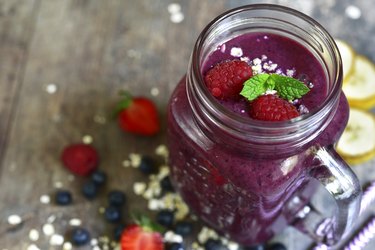
Fiber is one of weight loss's little secrets. In fact, having a fiber-rich shake as a snack or meal replacement each day might be just what you need to shed those extra pounds. Here's what you need to know to shake up your diet.
How Fiber Can Help You Lose Weight
Video of the Day
Fiber-rich, nutrient-dense foods, such as fruits, vegetables, legumes, beans, whole grains and low-fat dairy products, are relatively low in energy density (aka calories). Eating a lot of low-energy-dense foods helps fill you up on fewer calories, states the Food and Drug Administration, which in turn helps to keep your food intake under control.
Video of the Day
How does it work? Well, fiber comes from plant parts that your body isn't able to digest. But that's a good thing: That bulk moves through your gut more slowly and keeps you satisfied longer, so you don't feel as hungry and therefore eat less.
Indeed, a fiber-rich diet can help prevent obesity in young people and may also be linked to lower body fat, according to a May 2012 study published in The Journal of Clinical Endocrinology & Metabolism. It also promotes intestinal regularity, so it helps clean out your gut, too.
With that being said, there's a good chance you're not eating enough fiber-rich foods regularly. Adults only eat an average of 15 to 20 grams of fiber a day, according to the U.S. Department of Agriculture (USDA), which recommends 25 grams for women (up to age 50) and 38 grams for men. Women and men over 50 years of age should get 21 and 30 grams, respectively.
"I recommend adding fiber to each meal as it can help you feel fuller for longer. Feeling satiated and full ultimately may lead to a desired weight loss as you are less likely to overeat," Leah Kaufman, RD, CDE, CDN, tells LIVESTRONG.com.
Read more: Calorie-Restriction Diet Meal Plans
Shake Up Your Meal
Replacing one meal a day with a nutritious, high-fiber shake can help you create the calorie deficit required for weight loss and get you those extra grams of fiber that you've been missing. To lose 1 to 1 1/2 pounds per week, which is considered a safe and healthy rate of weight loss, you need to trim 500 to 700 calories from your daily diet, depending on your starting weight, according to the Mayo Clinic.
Think of it this way: If you normally go out for lunch with coworkers and take in 800 calories or more, skipping the lunch outing and whipping up a fiber-rich shake in the kitchen at your office can save you 500 calories. That one simple change is enough to lose 4 pounds in a month
Pick Healthy Ingredients that Pack a Punch
The USDA suggests eating meals with a variety of nutrient-dense foods across the food groups, so a fiber-rich meal-replacement shake should be no different. Here's how to make a drink that's both nutritious and delicious:
- Choose a low-calorie liquid base for your shake such as skim milk, or a non-dairy milk alternative like almond or coconut milk.
- Add in your fiber sources (check out the Mayo Clinic's chart): Berries are one of the highest-fiber fruits with 8 grams per cup. Leafy greens are another good source of fiber and abundant in vitamins and minerals, so throw in a handful of a mild green such as spinach.
- Round it out with protein and fat. Kaufman suggests avocado, chia or flax seeds as healthy sources of fat, and you could try powdered peanut butter or silken tofu for a low-cal protein. "Just because you are choosing to have liquids for that meal does not mean that you should sacrifice consuming your macronutrients," says Kaufman.
Watch Out for Pitfalls
It's best to make your own shakes with healthy, natural ingredients. If you want to go store-bought, check the nutrition labels because some shakes contain a lot of sugar, unwanted calories and unhealthy ingredients.
Try not to sabotage yourself either; it's easy to get carried away and throw everything but the kitchen sink in your shake, but you could be creating a calorie bomb.
And if you're feeling intimidated by all of the fresh goodness in your fridge, there are so many recipes (with nutritional info) right at your fingertips.
- Food and Drug Administration: "Dietary Fiber"
- Journal of Clinical Endocrinology and Metabolism: "Adolescent Fiber Consumption is Associated with Visceral Fat and Inflammatory Markers"
- U.S. Department of Agriculture: "Dietary Guidelines for Americans 2015-2020"
- Mayo Clinic: "Metabolism and Weight loss: How You Burn Calories"
- Mayo Clinic: "Chart of High-Fiber Foods"
- Leah Kaufman Nutrition
- Harvard Health Publishing: "Should I Be Eating More Fiber?"
- San Francisco Chronicle: "How to Get More Fiber from a Smoothie"